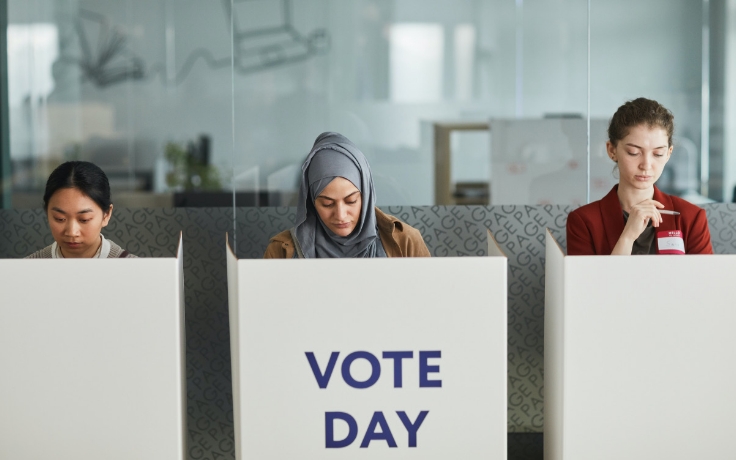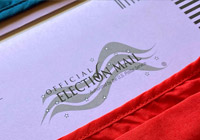THE HEAVILY AGRICULTURAL Yakima Valley in Washington state is about 875 miles and a world away from Los Angeles. But on January 19, the regions came together in a place that would surprise many Angelenos: U.S. District Court in the Western District of Washington.
It was there that the UCLA Voting Rights Project, working with the Mexican American Legal Defense and Education Fund and Chicago’s Campaign Legal Center, joined a group of Washington residents to file a lawsuit charging that a state commission had drawn legislative districts that disenfranchised Latino/a voters.
Deliberately manipulating lines in a manner that will skew the results of elections makes it impossible to govern states fairly or democratically; it is both common and illegal. In a February 13 UCLA Luskin Summit webinar, Ernest Herrera, regional counsel of the Western Region for MALDEF, described a pernicious process, detailing how, although a district in Washington had a very slight majority of Latino/a residents, its boundaries intentionally included communities with less active Latino/a voters as well as rural White residents who historically have voted in ways opposed to Latino/a interests.
Herrera described it as a “façade” district, a term that made it into court filings.
“This is an attempt to prevent Latinos from being able to elect a candidate of their choice to the state Legislature,” Herrera said during the webinar. “It looks like it’s a Latino opportunity district, but it’s actually not.”
The lawsuit may sound novel to those who get their legal knowledge from TV shows and John Grisham thrillers, but it is hardly surprising to voting rights experts at UCLA, where the Voting Rights Project has emerged in a short time as an aggressive and wide-reaching electoral watchdog. Its presence is felt from classrooms in Westwood to courtrooms across the country.
The project’s work embraces the past — the 1965 federal Voting Rights Act — and it confronts the present, by challenging attempts to dilute or even deny the right to cast a ballot. The VRP also aims to influence the future by giving states the tools to create their own voting rights protections.
It seeks to ensure what, in theory, should be the sacred right of communities to elect people who truly reflect and represent them. Not surprisingly, the ones most often threatened are low-income communities of color.
“Any attempts at any level of government to complicate the voting process, particularly for Latino communities, is a deliberate attempt to undermine the democratic process of our country,” Kevin de León, a Los Angeles city councilman, former president of the state Senate and current candidate for mayor, told me on a Sunday afternoon in March. De León, who spoke at the VRP’s opening event four years ago, and whose COVID mask has the word “VOTE” splashed across it, added, “We should always make voting as easy and as accessible as possible to all citizens, regardless of their country of origin or the color of their skin.”
UCLA and the right to vote
THE VRP WAS FOUNDED in 2018 by Chad Dunn, a civil rights attorney and UCLA lecturer in law and public policy, and Matt Barreto, a professor of political science and Chicano/a studies, who has served as an expert witness in many voting rights lawsuits. The two had worked together on court cases and found that Dunn’s legal acumen and experience dovetailed with Barreto’s social science expertise, which he uses to provide statistical analysis and testimony on topics including vote dilution and voter identification laws.
Dunn and Barreto recognized that there should be better integration between the legal and social science aspects of voting rights cases. They found a home for their project under the university’s Latino Policy and Politics Initiative, and launched it with a trio of aims: Train new lawyers and expert witnesses; develop new social science and legal theories for cases; and advance voting rights through national and local policy changes.
The threat to voting rights across the nation is no secret. Ever since a 2013 U.S. Supreme Court decision in the case of Shelby County v. Holder, protections have been eroded. “You have states like Texas and Florida and North Carolina,” Dunn said, “that are adopting omnibus voter suppression laws designed to make it harder to vote.”
A battalion of prominent organizations fights high-profile efforts to stifle registration or otherwise disenfranchise voters. The VRP is unique because it operates on a localized basis. Sonni Waknin, its program manager and voting rights counsel, said much of the work challenges representation on city councils, school boards and county commissions.
This might not generate widespread media coverage, but Waknin notes that when a community is prevented from electing a representative of its choice, the impacts can be severe.
“We think about statewide legislative maps and congressional maps and presidential elections, but what really impacts people every day is what their school board is doing. Are their kids getting an equal education?” she said. “Or the county commission — that dictates where hospitals are and roads are built. Will they improve the central business district in the Latino area of town, or are they going to build a Wal-Mart in the White part of town?”
The VRP has a full-time staff, but the project’s power also comes from a university class. During a year long course, dozens of law and social science students investigate jurisdictions across the country that might be in violation of voting rights laws, and they help draft a federal complaint. By the end of each spring semester, not only are some students ready to graduate and join national voting rights organizations but the VRP has cases it can file.
“We’ll have draft discovery ready, [and] proposed deposition questions,” Dunn said. “We’ll have a complete lawsuit, some preliminary expert reports or analysis. Then the VRP, on a funding or resource availability basis, will ultimately proceed with these cases.”
The research and work runs deeply. In the past year alone, the VRP has delved into cases that aim to protect the rights of Navajo Nation residents in New Mexico as well as Black and Latino/a inhabitants of Galveston County, Texas. During the 2020 election, the VRP was involved in three separate voting rights projects in Georgia.
Latino representation in California
CALIFORNIA ALSO GETS ITS DUE. As various decennial redistricting processes unfolded across the state after the 2020 Census, the VRP engaged in numerous efforts to make sure that communities with heavy Latino/a growth and other demographic changes were being properly represented.
The VRP authored a 24-page paper examining population shifts in Orange County and urged that a Latino/a seat be created on the Board of Supervisors. The project wrote a 10-page memo addressing changes in Riverside County, pointing out that its growth was almost exclusively from Latino/as. The VRP urged the county to adopt maps with seats for at least two Latino/a-majority districts. Another VRP paper sought to persuade supervisors in Yolo County to reject maps that would split the Latino/a population in the only district where a Latino/a had been elected.
“You have a lot of counties in California, like Yolo, where there was nobody to call until the VRP existed,” Dunn said. “At the end of the day, because of all the information and advocacy we were able to bring to bear, [Yolo] County preserved the Latino/a district. It plainly would not exist if it wasn’t for any of that work.”
The VRP’s efforts in California are critical not just for the communities of today but for the playbook they provide for the future. The population diversification that the state experienced in recent decades — it became much less White — is expected to occur in many other states during decades to come. And history shows that those who have traditionally held power will fight aggressively to keep it.
Changes the VRP helped bring about in Orange, Riverside and Yolo counties, Dunn notes, required advocates who could battle on a local level. This could play out elsewhere in the future.
“It is a struggle,” Dunn said. “It won’t necessarily turn out to be a fair-governance model like California has [now] unless there are people doing the work to make it so.”
The VRP’s budget and resources are limited, so it has to pick its battles. That is partly why the team constructed a unique tool.
In March 2021, it published a document titled the “Model Code for a State-Level Voting Rights Act.” The text includes language for a bill that lawmakers can utilize.
The U.S. Constitution does not specify a right to vote. Federal protections of voting access are a “floor,” Dunn and Waknin suggest, and not a “ceiling.” This provides an opportunity, they say, for states to create their own laws that guarantee the right to visit the ballot box.
Indeed, California, Washington and Virginia are among states that have created their own voting rights acts. The VRP’s “Model Code” includes language that could improve protections in those states and help legislators elsewhere author their own laws.
Waknin draws a powerful example showing why this is needed.
“It’s very similar to, I think, what’s happening on the state level with abortion rights,” she said. “States are under- standing that the federal government is the floor, and they can offer more robust protections. As rights keep getting chipped away on the federal level, it’s very important to have a more robust state-level process.”
Battles underway in courtrooms and communities across the nation prove how critical this work is.

























